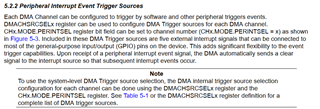请注意,本文内容源自机器翻译,可能存在语法或其它翻译错误,仅供参考。如需获取准确内容,请参阅链接中的英语原文或自行翻译。
部件号:TMS320F28379D 工具/软件:
我想收集电压信号并使用 DMA 将其传输到指定的数组。按照例行公事修改后、发现程序无法触发 DMA 的传输中断结束。我尝试在每次 ADC 转换后清除 ADC 的中断标志、DMA 能够正常传输数据并进入结束中断。但是、我在用户手册中看到 DMA 将主动向中断源发出中断清除信号。DMA

我想知道为什么我的程序没有清除 ADC 的中断标志。ADC 的 DMA 传输程序中没有代码清除 ADC 中断、甚至没有启用相应的中断功能、但程序工作正常。这是我的代码、乞求帮助。
#include "driverlib.h"
#include "device.h"
#include "F28x_Project.h"
#define RESULTS_BUFFER_SIZE 256
void initADC(void);
void initEPWM(void);
void initADCSOC(void);
void initializeDMA(void);
void configureDMAChannels(void);
__interrupt void adcA1ISR(void);
__interrupt void dmach1ISR(void);
#pragma DATA_SECTION(adcAResults, "ramgs0");
uint16_t adcAResults[RESULTS_BUFFER_SIZE];
volatile uint16_t bufferFull;
void main(void)
{
// Initialize device clock and peripherals
Device_init();
// Disable pin locks and enable internal pullups.
Device_initGPIO();
/*
#ifdef _STANDALONE
#ifdef _FLASH
// Send boot command to allow the CPU2 application to begin execution
Device_bootCPU2(C1C2_BROM_BOOTMODE_BOOT_FROM_FLASH);
#else
// Send boot command to allow the CPU2 application to begin execution
Device_bootCPU2(C1C2_BROM_BOOTMODE_BOOT_FROM_RAM);
#endif // _FLASH
#endif // _STANDALONE
*/
// Initialize PIE and clear PIE registers. Disables CPU interrupts.
Interrupt_initModule();
// Initialize the PIE vector table with pointers to the shell Interrupt
// Service Routines (ISR).
Interrupt_initVectorTable();
// Interrupts that are used in this example are re-mapped to ISR functions
// found within this file.
Interrupt_register(INT_ADCA1, &adcA1ISR);
// ISR for DMA ch1 - occurs when DMA transfer is complete
Interrupt_register(INT_DMA_CH1, &dmach1ISR);
// Enable specific PIE & CPU interrupts:
// DMA interrupt - Group 7, interrupt 1
Interrupt_enable(INT_DMA_CH1);
// Set up the ADC and the ePWM and initialize the SOC
initADC();
initEPWM();
initADCSOC();
// Initialize the DMA & configure DMA channels 1
initializeDMA();
configureDMAChannels();
bufferFull = 0;
// Enable ADC interrupt
Interrupt_enable(INT_ADCA1);
// Clearing all pending interrupt flags
DMA_clearTriggerFlag(DMA_CH1_BASE); // DMA channel 1
HWREGH(ADCA_BASE + ADC_O_INTFLGCLR) = 0x1U; // ADCA
// Enable Global Interrupt (INTM) and realtime interrupt (DBGM)
EINT;
ERTM;
for(;;)
{
// Start DMA
DMA_startChannel(DMA_CH1_BASE);
// Start ePWM1, enabling SOCA and putting the counter in up-count mode
EPWM_enableADCTrigger(EPWM1_BASE, EPWM_SOC_A);
EPWM_setTimeBaseCounterMode(EPWM1_BASE, EPWM_COUNTER_MODE_UP);
// Wait while ePWM1 causes ADC conversions which then cause interrupts.
// When the results buffer is filled, the bufferFull flag will be set.
while(bufferFull == 0)
{
}
bufferFull = 0; // Clear the buffer full flag
// Stop ePWM1, disabling SOCA and freezing the counter
EPWM_disableADCTrigger(EPWM1_BASE, EPWM_SOC_A);
EPWM_setTimeBaseCounterMode(EPWM1_BASE, EPWM_COUNTER_MODE_STOP_FREEZE);
// Software breakpoint. At this point, conversion results are stored in
// adcAResults.
// Hit run again to get updated conversions.
ESTOP0;
}
}
// Function to configure and power up ADCA.
void initADC(void)
{
// Set ADCDLK divider to /4
ADC_setPrescaler(ADCA_BASE, ADC_CLK_DIV_4_0);
// Set resolution and signal mode (see #defines above) and load
// corresponding trims.
ADC_setMode(ADCA_BASE, ADC_RESOLUTION_12BIT, ADC_MODE_SINGLE_ENDED);
// Set pulse positions to late
ADC_setInterruptPulseMode(ADCA_BASE, ADC_PULSE_END_OF_CONV);
// Power up the ADC and then delay for 1 ms
ADC_enableConverter(ADCA_BASE);
DEVICE_DELAY_US(1000);
}
// Function to configure ePWM1 to generate the SOC.
void initEPWM(void)
{
// Disable SOCA
EPWM_disableADCTrigger(EPWM1_BASE, EPWM_SOC_A);
// Configure the SOC to occur on the first up-count event
EPWM_setADCTriggerSource(EPWM1_BASE, EPWM_SOC_A, EPWM_SOC_TBCTR_U_CMPA);
EPWM_setADCTriggerEventPrescale(EPWM1_BASE, EPWM_SOC_A, 1);
// Set the compare A value to 1000 and the period to 1999
// Assuming ePWM clock is 100MHz, this would give 50kHz sampling
// 50MHz ePWM clock would give 25kHz sampling, etc.
// The sample rate can also be modulated by changing the ePWM period
// directly (ensure that the compare A value is less than the period).
EPWM_setCounterCompareValue(EPWM1_BASE, EPWM_COUNTER_COMPARE_A, 49);
EPWM_setTimeBasePeriod(EPWM1_BASE, 99);
// Set the local ePWM module clock divider to /1
EPWM_setClockPrescaler(EPWM1_BASE,
EPWM_CLOCK_DIVIDER_1,
EPWM_HSCLOCK_DIVIDER_1);
// Freeze the counter
EPWM_setTimeBaseCounterMode(EPWM1_BASE, EPWM_COUNTER_MODE_STOP_FREEZE);
}
// Function to configure ADCA's SOC0 to be triggered by ePWM1.
void initADCSOC(void)
{
// Configure SOC0 of ADCA to convert pin A1. The EPWM1SOCA signal will be
// the trigger.
// - For 12-bit resolution, a sampling window of 15 (75 ns at a 200MHz
// SYSCLK rate) will be used.
// - NOTE: A longer sampling window will be required if the ADC driving
// source is less than ideal (an ideal source would be a high bandwidth
// op-amp with a small series resistance). See TI application report
// SPRACT6 for guidance on ADC driver design.
ADC_setupSOC(ADCA_BASE, ADC_SOC_NUMBER0, ADC_TRIGGER_EPWM1_SOCA,
ADC_CH_ADCIN0, 15);
// Set SOC0 to set the interrupt 1 flag. Enable the interrupt and make
// sure its flag is cleared.
ADC_setInterruptSource(ADCA_BASE, ADC_INT_NUMBER1, ADC_SOC_NUMBER0);
ADC_enableInterrupt(ADCA_BASE, ADC_INT_NUMBER1);
ADC_clearInterruptStatus(ADCA_BASE, ADC_INT_NUMBER1);
}
void initializeDMA(void)
{
// Perform a hard reset on DMA
DMA_initController();
// Allow DMA to run free on emulation suspend
DMA_setEmulationMode(DMA_EMULATION_FREE_RUN);
}
void configureDMAChannels(void)
{
// DMA channel 1 set up for ADCA
DMA_configAddresses(DMA_CH1_BASE, (uint16_t *)&adcAResults,
(uint16_t *)(ADCARESULT_BASE+ADC_SOC_NUMBER0));
DMA_configBurst(DMA_CH1_BASE, 1, 0, 0);
DMA_configTransfer(DMA_CH1_BASE, RESULTS_BUFFER_SIZE, 0, 1);
DMA_configMode(DMA_CH1_BASE, DMA_TRIGGER_ADCA1,
(DMA_CFG_ONESHOT_DISABLE | DMA_CFG_CONTINUOUS_DISABLE |
DMA_CFG_SIZE_16BIT));
DMA_enableTrigger(DMA_CH1_BASE);
DMA_disableOverrunInterrupt(DMA_CH1_BASE);
DMA_setInterruptMode(DMA_CH1_BASE, DMA_INT_AT_END);
DMA_enableInterrupt(DMA_CH1_BASE);
}
// ADC A Interrupt 1 ISR
__interrupt void adcA1ISR(void)
{
// Add the latest result to the buffer
//adcAResults[index++] = ADC_readResult(ADCARESULT_BASE, ADC_SOC_NUMBER0);
// Clear the interrupt flag
ADC_clearInterruptStatus(ADCA_BASE, ADC_INT_NUMBER1);
// Check if overflow has occurred
/*
if(true == ADC_getInterruptOverflowStatus(ADCA_BASE, ADC_INT_NUMBER1))
{
ADC_clearInterruptOverflowStatus(ADCA_BASE, ADC_INT_NUMBER1);
ADC_clearInterruptStatus(ADCA_BASE, ADC_INT_NUMBER1);
}
*/
// Acknowledge the interrupt
Interrupt_clearACKGroup(INTERRUPT_ACK_GROUP1);
}
#pragma CODE_SECTION(dmach1ISR, ".TI.ramfunc");
__interrupt void dmach1ISR(void)
{
bufferFull = 1;
// Acknowledge interrupt
Interrupt_clearACKGroup(INTERRUPT_ACK_GROUP7);
}
